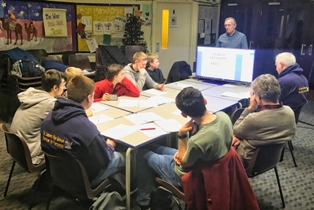Developing young ringers' conducting skills
I recently delivered the ART conducting workshop to the Lancashire Lads and Lasses youth team of the Lancashire Association of Change Ringers. This was reported in the Ringing World (10 January, 2020 ; p.52). I am not an expert on youth development and my only connection with this flourishing group has been to deliver the workshop. Others must take credit for setting up and coaching the group to participate creditably in the 2019 Ringing World National Youth Competition. However, I will try to say something brief and useful about using the workshop to contribute to youth development.
There is a strong concern in the LACR to continue the tradition of ringing, keeping it alive and the bells available for future generations. The essence of the ringing tradition at its best is that novices mature with help, to become informed, appreciative listeners and capable performers who can convey their knowledge, skills and enjoyment, ably and generously to the next generation of novices.
A ringing community thrives through the combination of ‘social glue’ with concern for performance. In this atmosphere members of the band are committed towards each other and towards the enjoyment of ringing at the best level of proficiency they can attain together. Individuals are stimulated to emulate the successes of their peers. They receive help, encouragement and support, to gain self-confidence, develop adventurous ringing ambitions and fulfil them.
This was the atmosphere I enjoyed in the Manchester University Guild of Change Ringers when I became a student there in 1969. I don’t want to bore readers with reminiscences of making Shrove Tuesday pancakes together, organising our own weekend ringing tours and sleeping on the floor at the homes of our colleagues’ parents. It was possible to move on relatively swiftly, from ringing only Grandsire Doubles to ringing spliced Surprise Major, by dint of assiduous homework and access to the knowledge imparted by colleagues only a year or two older than oneself.
The existence of the LACR youth group provides its members with the chance to experience this kind of collegiate learning environment, supported but not dominated by the adults. Independence breeds initiative and confidence to explore.
My aim in delivering the workshop was to give the students a grounding and a basic understanding of calling touches and using the coursing order. This would serve as a ‘taster’ and kindle continuing interest. I aimed to impart information in bite-sized chunks, interspersed with plenty of practical ringing and sufficient breaks to give young brains a rest and young bodies a short game of five a side football. I found a way to ensure that everyone derived the maximum benefit from every conducting opportunity and to ensure that everyone had the chance to shout ‘bob’ at each of the calling positions.
I restricted the content of the session to Plain Bob Minor which I see as a gateway to a wide range of rewarding Major and Minor methods. It kept things simple and avoided overloading inexperienced ringers with a quantity of theory they could not assimilate. The touches were rung and called confidently and accurately, because attendance was conditional upon being able to ring touches of Bob Minor confidently and perhaps because each ringer was briefed carefully before each touch so that the conductors could be successful. What I did not expect was that, within a month of the workshop, the students would ring their first quarter peal of Plain Bob Minor together, conducted by one of their own number.
This will set the stage for higher things. The students are now better equipped to set and pursue their own goals. The students will contribute their boosted confidence and competence to enhance ringing in their parent bands and branches and within their own select group.
